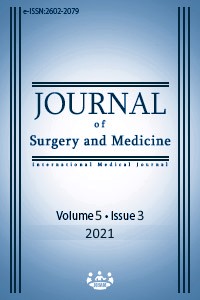Should middle ear pressure and hearing loss be evaluated prior to septoplasty? A prospective cohort study
Keywords:
Septal deviation, hearing loss, middle earAbstract
Background/Aim: Nasal resistance is primarily caused by the deviation of the nasal septum at the level of the inferior turbinate and isthmus nasi. The pressure of the nasopharynx may decrease to less than that of the middle ear, from where the air would drain, thus creating a cavity with negative pressure. Therefore, pathological phenomena in the nasal cavity can affect the ventilation of the middle ear. In this study, we aimed to investigate how hearing is changed by septum deviation (SD) affecting middle ear pressure, and in case of hearing loss, whether there is any improvement after nasal surgery. Methods: Sixty-seven patients were admitted to our Otorhinolaryngology clinic with nasal obstruction and hearing loss complaints, and 50 patients (≥18 years of age) with nasal congestion due to SD were included in this study. Septoplasty was performed to fifty patients and lateralization of SD was noted. Pure tone audiometric and tympanometric evaluations were performed preoperatively and postoperatively. Gain of hearing and gain of pressure after surgery were recorded, which were statistically compared between the groups. Results: Of the 50 patients with nasal congestion and hearing impairment included in our study, 27 were male and 23 were female. The mean age of all cases was 32.08 (9.44) years, ranging between 18–56 years. Among forty-two patients with unilateral SD, thirty-seven (88%) had negative middle ear pressure. The lowest pure-tone-threshold was 1 dB, and the highest was 35 dB on the side with the deviation. On the side without SD, the lowest threshold was 8 dB, and the highest was 28 dB. Pure-tone-thresholds between 500 and 2,000 Hz were within normal range in seventy-six ears. Hearing loss was present in twenty-four ears. Postoperatively, the lowest hearing gain was 0 dB, and the highest was 15 dB on the side with the SD. On the side without SD, the lowest and highest hearing gains were 0 dB and 11 dB. Conclusion: The negative pressure in the middle-ear due to SD may affect hearing. Hearing loss does not result from every deviation but occurs only when sufficient negative pressure is formed in the middle-ear.
Downloads
References
Tan J, Han D, Wang J, Liu T, Wang T, Zang H, et al. Numerical simulation of normal nasal cavity airflow in Chinese adult: a computational flow dynamics model. Eur Arch Otorhinolaryngol. 2012;269(3):881-9. doi: 10.1007/s00405-011-1771-z.
Nishijima H, Kondo K, Yamamoto T, Nomura T, Kikuta S, Shimizu Y, et al. Influence of the location of nasal polyps on olfactory airflow and olfaction. Int Forum Allergy Rhinol. 2018;8(6):695-706. doi: 10.1002/alr.22089.
Flisberg K. The effects of vacuum on the tympanic cavity. Otolaryngol Clin North Am. 1970;3(1):3-13.
Miller AJ, Gianoli GJ. Eustachian tube dysfunction. J La State Med Soc. 1996;148(8):329–33.
Brookler KH. Otitic barotrauma. Laryngoscope. 1973;83(6):966-8. doi: 10.1288/00005537-197306000-00015.
Scott -Brown's Otorhinolaryngology and Head and Neck Surgery, Third Edition; Vol 3: Diseases of the Ear, Nose and Throat, 1996.
Akyıldız N. Kulak Hastalıkları ve Mikroşirurjisi. 1. Cilt, Bilimsel Tıp, Ankara, 1998
Doğan R. The effect of types of nasal septum deviation on the Eustachian tube function. Bezmialem Science. 2019;7(1):33-7. doi: 10.14235/bas.galenos.2017.2285
Flint PW, Haughey BH, Lund V, et al. Cummings otolaryngology: Head and neck surgery. Elsevier/Saunders; 2015.
Kaya M, Dağlı E, Kırat S. Does Nasal Septal Deviation Affect the Eustachian Tube Function and Middle Ear Ventilation? Turk Arch Otorhinolaryngol. 2018;56(2):102–5. doi: 10.5152/tao.2018.2671.
Duran K, Fatih Y, Doğan M. Middle ear pressure after septoplasty. J Craniofac Surg. 2014:25(1):e19-21 doi: 10.1097/SCS.0b013e3182a2ed3d.
Eyigör H, Osma U, Yılmaz MD, Aygener N, Buyruk A. [The effect of operation success on middle ear ventilation in patients with nasal septal deviation]. Kulak Burun Bogaz Ihtis Derg. 2013;23(1):26-31. doi: 10.5606/kbbihtisas.2013.37233.
Güldüz M, Akdoğan MV, Büyüklü F. Septum Deviasyonunun Orta Kulak Rezonans Frekansı Üzerine Etkisi: Prospektif Klinik Çalışma. KBB ve BBC Dergisi. 2018;26(1):12-6. doi: 10.24179/kbbbbc.2018-59891
Downloads
- 899 812
Published
Issue
Section
How to Cite
License
Copyright (c) 2021 Bahadır Baykal
This work is licensed under a Creative Commons Attribution-NonCommercial-NoDerivatives 4.0 International License.
















